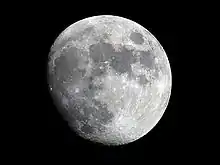Diophantus (crater)
Diophantus is a lunar impact crater that lies in the southwestern part of the Mare Imbrium. It was named after ancient Greek mathematician Diophantus.[1] It forms a pair with the larger crater Delisle to the north. Diophantus has a wide inner wall and a low central rise. To the north of Diophantus is the sinuous rille designated Rima Diophantus, named after the crater. Diophantus C lies near the exterior of the southwest wall.
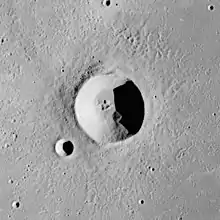 Apollo 15 image | |
| Coordinates | 27.6°N 34.3°W |
|---|---|
| Diameter | 19 km |
| Depth | 3.0 km |
| Colongitude | 34° at sunrise |
| Eponym | Diophantus |
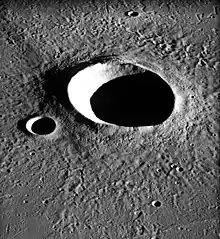
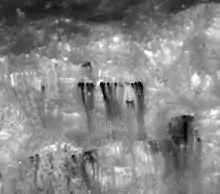
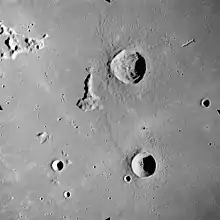
Rima Diophantus
This cleft follows a generally east–west path across the Mare Imbrium. It is centered at selenographic coordinates 31.0° N, 32.0° W, and has a maximum diameter of 150 km.
Small craters
Several tiny craters north of Diophantus have been assigned names by the IAU. These are listed in the table below.
| Crater | Coordinates | Diameter | Name source |
|---|---|---|---|
| Isabel | 28.2°N 34.1°W | 1 km | Spanish feminine name |
| Louise | 28.5°N 34.2°W | 0.8 km | French feminine name |
| Samir | 28.5°N 34.3°W | 2 km | Arabic masculine name |
| Walter1 | 28.0°N 33.8°W | 1 km | German masculine name |
| 1 | Not to be confused with the large crater Walther in the southern hemisphere which is misidentified as 'Walter' in some publications |

The crater Samir has bright rays that extend for over 70 km.
Satellite craters
By convention these features are identified on lunar maps by placing the letter on the side of the crater midpoint that is closest to Diophantus.
| Diophantus | Latitude | Longitude | Diameter |
|---|---|---|---|
| B | 29.1° N | 32.5° W | 6 km |
| C | 27.3° N | 34.7° W | 5 km |
| D | 26.9° N | 36.3° W | 4 km |
The following craters have been renamed by the IAU.
- Diophantus A — See Artsimovich.
References
- "Diophantus (crater)". Gazetteer of Planetary Nomenclature. USGS Astrogeology Research Program.
- Andersson, L. E.; Whitaker, E. A. (1982). NASA Catalogue of Lunar Nomenclature. NASA RP-1097.
- Bussey, B.; Spudis, P. (2004). The Clementine Atlas of the Moon. New York: Cambridge University Press. ISBN 978-0-521-81528-4.
- Cocks, Elijah E.; Cocks, Josiah C. (1995). Who's Who on the Moon: A Biographical Dictionary of Lunar Nomenclature. Tudor Publishers. ISBN 978-0-936389-27-1.
- McDowell, Jonathan (July 15, 2007). "Lunar Nomenclature". Jonathan's Space Report. Retrieved 2007-10-24.
- Menzel, D. H.; Minnaert, M.; Levin, B.; Dollfus, A.; Bell, B. (1971). "Report on Lunar Nomenclature by the Working Group of Commission 17 of the IAU". Space Science Reviews. 12 (2): 136–186. Bibcode:1971SSRv...12..136M. doi:10.1007/BF00171763.
- Moore, Patrick (2001). On the Moon. Sterling Publishing Co. ISBN 978-0-304-35469-6.
- Price, Fred W. (1988). The Moon Observer's Handbook. Cambridge University Press. ISBN 978-0-521-33500-3.
- Rükl, Antonín (1990). Atlas of the Moon. Kalmbach Books. ISBN 978-0-913135-17-4.
- Webb, Rev. T. W. (1962). Celestial Objects for Common Telescopes (6th revised ed.). Dover. ISBN 978-0-486-20917-3.
- Whitaker, Ewen A. (1999). Mapping and Naming the Moon. Cambridge University Press. ISBN 978-0-521-62248-6.
- Wlasuk, Peter T. (2000). Observing the Moon. Springer. ISBN 978-1-85233-193-1.
External links
| Wikimedia Commons has media related to Diophantus (crater). |
- LTO-39B3 Diophantus — L&PI topographic map of crater and vicinity.
- "Featured Image: Dark Streaks in Diophantus Crater". Lunar Reconnaissance Orbiter. NASA. February 23, 2011. Retrieved 2011-03-18.
